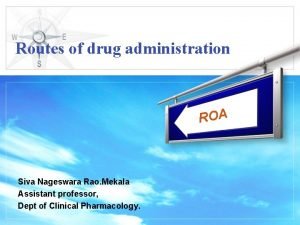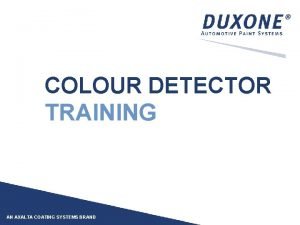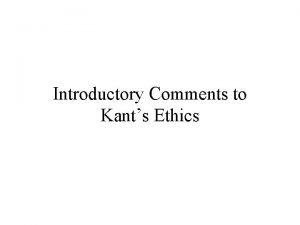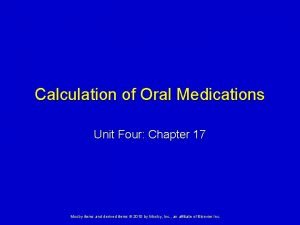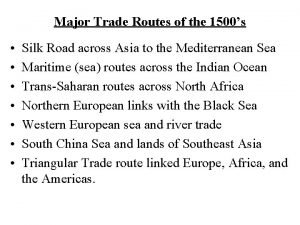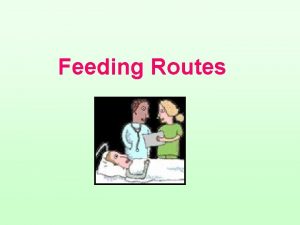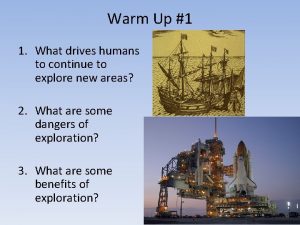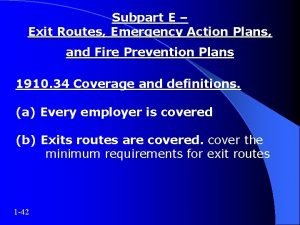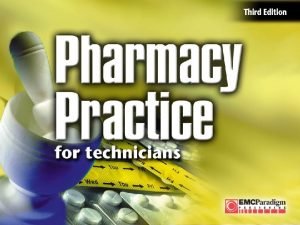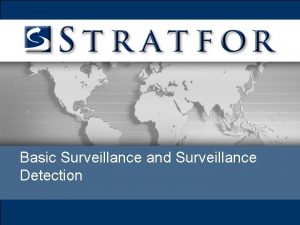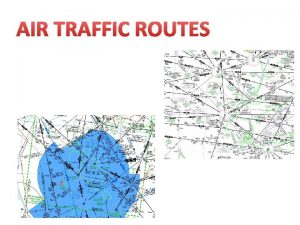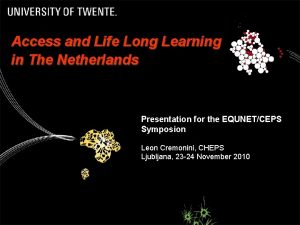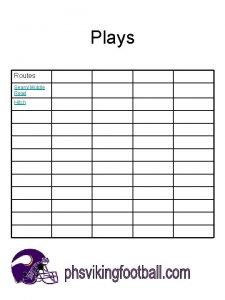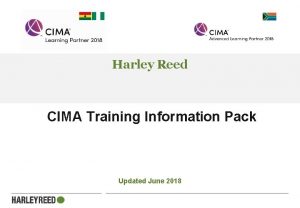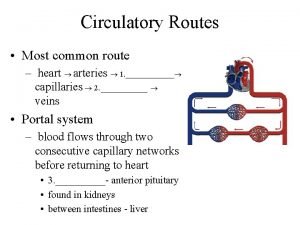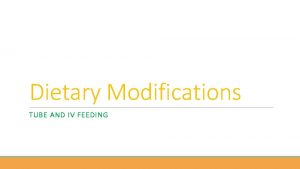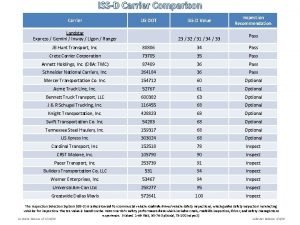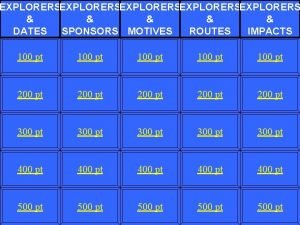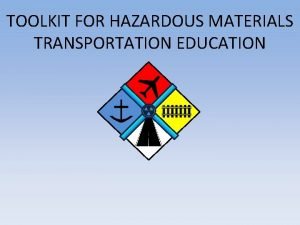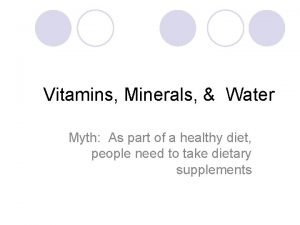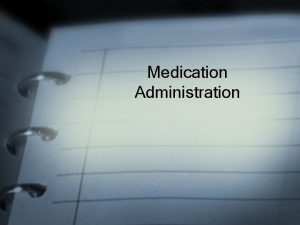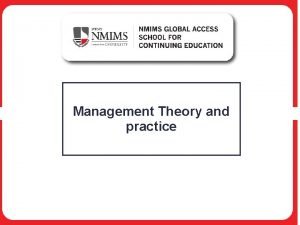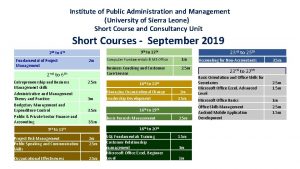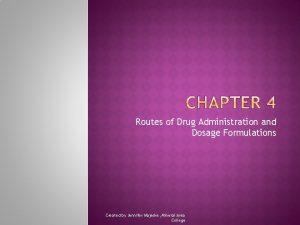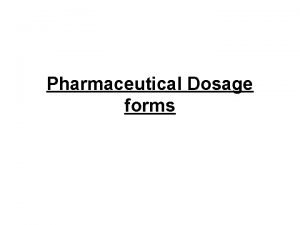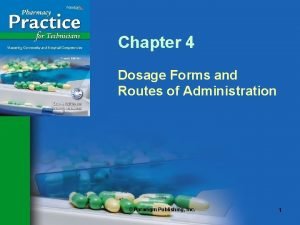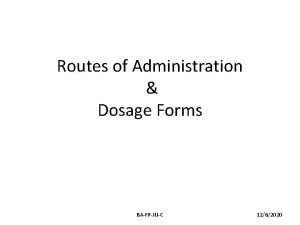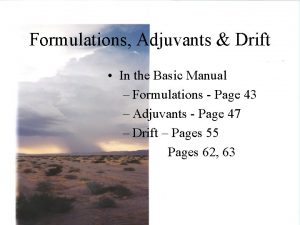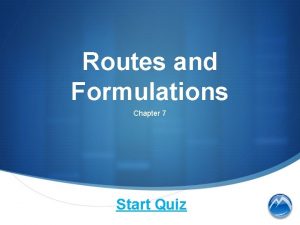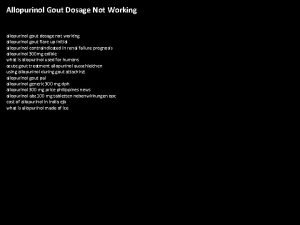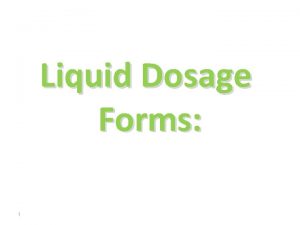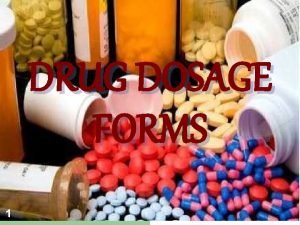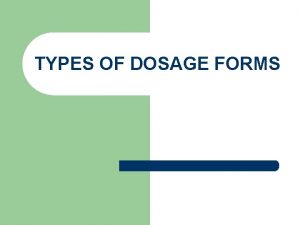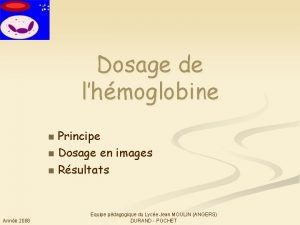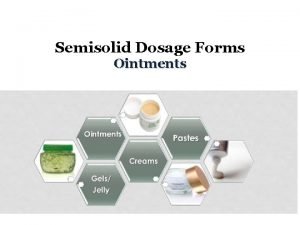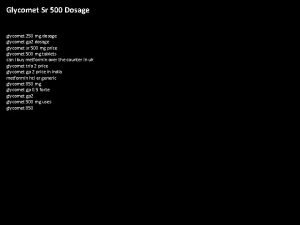6 Dosage Formulations and Routes of Administration Sources



































































- Slides: 67

6 Dosage Formulations and Routes of Administration

Sources of Drugs • Natural drug sources § Occur in nature and are naturally occuring § Derived or extracted from plants, animals, and minerals

Sources of Drugs • Natural drug sources § Plant sources include: • Acetylsalicyclic acid (aspirin) derived from white willow bark • Cocaine derived from the coca plant • Codeine and morphine derived from the opium poppy plant

Sources of Drugs • Natural drug sources § Animal sources include: • • Bovine insulin derived from cow pancreas Porcine insulin derived from pig pancreas Pepsin derived from cow stomach Thyroid hormones derived from pig thyroid gland

Sources of Drugs • Natural drug sources § Mineral sources include: • Ferrous sulfate (iron) to treat iron deficiencies • Gold used to treat arthritis • Magnesium for milk of magnesia (laxative and antacid)

Sources of Drugs • Natural drug sources § Mineral sources include: • Potassium to supplement low potassium levels • Sodium chloride is common base solution for IV therapies • Zinc for skin protectants and sunscreen

Sources of Drugs • Synthetic drug sources § Produced in a laboratory, not naturally occuring § Semisynthetic: naturally occuring substance that has been chemically altered § Synthesized: made in laboratory to imitate a naturally occurring drug

Sources of Drugs • Synthetic drug sources § Examples of synthetic drugs • Adrenalin • Synthesized epinephrine for treating hypersensitivity and asthma attacks • Amoxicillin, ampicillin, and piperacillin • Semi-synthetic pencillins to treat various infections

Sources of Drugs • Synthetic drug sources § Examples of synthetic drugs • Barbiturates • Synthetic CNS depressants • Oxy. Contin • Synthetic opiate for pain management

Sources of Drugs • Genetically engineered drug sources § Recombinant DNA • Combining two different DNA strands to produce a new strand of DNA or r. DNA • Human insulin created to treat diabetes • Recombinant hepatitis B vaccine

Sources of Drugs • Genetically engineered drug sources § Monoclonal antibodies (MAbs) • Hybrid cells created in laboratory from animals; used to treat tumors and diagnose various conditions • Rituxan, Zevalin, Erbitux, Avastin: used in the treatment of various cancers

Drug Nomenclature • Chemical name § Reflects the chemical structure of the compound § Often long and hard to remember and pronounce § Named according to guidelines from the International Union of Pure and Applied Chemistry (IUPAC) § Used primarily in research settings

Drug Nomenclature • Generic name § Convenient and concise § Assigned by manufacturer in collaboration with the FDA § Not capitalized § May be used by anyone—not restricted by copyright or tradmark § Used in the USP and the USP-NF

Drug Nomenclature • Trade or brand name § Registered or trademarked by a specific producer or manufacturer to identify its particular drug § This name cannot be used by other manufacturers but a generic may be sold under more than one trade name. § Usually capitalized § Also called the "proprietary name"

Classification of Drugs • Classifications based on: § Chemical ingredients § Method by which the drug is used § Area of the body that is treated • Two usual classification methods § Therapeutic use § Mechanism of action

Dosage Formulations • Dosage forms § How medication is prepared for administration to the patient § Solid or liquid § Single medication may be available in multiple dosage forms for use at various disease states, patient ages, and desired results.

Dosage Formulations • Solid dosage forms § Most widely available form § Can be administered orally, rectally, vaginally, or topically § Advantages and disadvantages

Dosage Formulations • Solid dosage forms § Tablets • Small formed shapes usually taken by mouth • Active and inert ingredients work together to ensure tablet is easy to swallow, taste, digestible, and releases drug at proper time.

Dosage Formulations • Solid dosage forms § Tablets • Molded tablets made with mold and wet materials • Compressed tablets formed by diepunching compressed, powdered, crystalline, or granular substances into a uniform shape, usually has a film, sugar coating, or enteric coating

Dosage Formulations • Solid dosage forms § Tablets • Caplets are film-coated tablets in the shape of a capsule. • Chewable tablets should be chewed for desired results. • Effervescent tablets dissolve in liquid before administration. • Fast dissolving tablets can be taken orally without water.

Dosage Formulations • Solid dosage forms § Tablets • Sublingual tablets disintegrate and are absorbed under the tongue. • Buccal tablets disintegrate in the buccal pouch, between the gums and the cheek. • Vaginal tablets are dissolved and absorbed through the mucous lining of vagina.

Dosage Formulations • Solid dosage forms § Capsules have drug contained in a shell • Soft gelatin shells are soft and elastic, flexible during administration, and can't be broken apart. • Hard gelatin shells have two oblong halves joined together, which can be separated if necessary.

Dosage Formulations • Solid dosage forms § Lozenges (also called pastilles or troches) • Hard, disk-shaped solid form in a sugar base • Remains in the patient's mouth until has been completely dissolved and all medication releases

Dosage Formulations • Solid dosage forms § Powders • Usually produced in large supplies for bulk compounding • Can be used internally or externally • Individual doses packaged in a powder paper

Dosage Formulations • Solid dosage forms § Granules • Made from wetted then dried powders ground into course, nonuniform particles • Commonly used in pediatric antibiotic suspensions • Dissolved in distilled water

Dosage Formulations • Solid dosage forms § Medicated sticks • For topical application of local anesthetics, sunscreens, antivirals, antibiotics, and cosmetics

Dosage Formulations • Semisolid dosage forms § Suppositories • Administer medication via rectum, vagina, or urethral tract • Melt or dissolve at body temperature • Used for babies and other instances where oral dosing may not be practical § Creams may or may not contain medication; oil-in-water or water-in-oil bases.

Dosage Formulations • Semisolid dosage forms § Ointments are applied externally to the skin or mucous membranes. • Oleaginous ointments: emollients to soothe and cool. Hydrophobic, meaning not easy to wash off.

Dosage Formulations • Semisolid dosage forms § Ointments are applied externally to the skin or mucous membranes. • Water-soluble ointments: contain no fat or water, easily wash off. Can be mixed with nonaqueous or solid medication • Anydrous ointments: absorb water, turning into a water-in-oil emulsion

Dosage Formulations • Semisolid dosage forms § Ointments are applied externally to the skin or mucous membranes. • Emulsions • Emollient bases made of water-in-oil (occlusive) or oil-in-water (nonocclusive) • Pastes • Stiff or very viscous ointments that do not melt or soften at body temperature; usually contain at least 20% solids

Dosage Formulations • Liquid dosage forms § Solutions • Medication is completely dissolved and evenly distributed (homogeneous) and quickly absorbed • Aqueous solutions use purified/sterile water as vehicle for douches, irrigating solutions, enemas, washes, and sprays.

Dosage Formulations • Liquid dosage forms § Solutions • Viscous aqueous solutions use purified/sterile water; thick, sticky— either liquid or semisolid; syrups, jellies, and mucilages.

Dosage Formulations • Liquid dosage forms § Solutions • Nonaqueous solutions don't use water, usually alcohol, glycerin, or propylene glycol.

Dosage Formulations • Liquid dosage forms § Solutions • Hydro-alcoholic solutions use alcohol and water as vehicle or dissolving agent. Example: • Elixirs: liquid preparations with flavored water and alcohol mixtures for oral administration. Many drugs dissolve more easily this way. Range of alcohol contents varies from 2– 30%.

Dosage Formulations • Liquid dosage forms § Solutions • Hydro-alcoholic solutions use alcohol and water as vehicle or dissolving agent. Example: • Aromatic elixirs are nonmedical, used to mask unpleasant medicine taste.

Dosage Formulations • Liquid dosage forms § Solutions • Alcoholic solutions use no water, usually ethyl or ethanol alcohols. • Collodions contain pyroxylin, applied to skin, can carry an added medication • Spirits contain volatile and aromatic substances, administered internally or inhaled.

Dosage Formulations • Liquid dosage forms § Solutions • Alcoholic solutions use no water, usually ethyl or ethanol alcohols. • Glycerite contains medication dissolved in glycerin, then is mixed into a water or alcohol vehicle, often has viscous, jelly-like consistency, rarely used today.

Dosage Formulations • Suspensions § Contain very fine solid particles mixed with gas, liquid, or solid § Break down faster than tablets or capsules § Must be shaken well before use

Dosage Formulations • Suspensions § Usually intended for oral ingestion where large amount of medication is needed. § Other routes • Ophthalmic, parenteral, otic, and rectal

Dosage Formulations • Suspensions § Magmas and milks • Suspensions of undissolved medications in water § Lotions • For external use only

Dosage Formulations • Suspensions § Gels • Similar to magmas and milks but particles are smaller, used for oral or topical administration § Extractives • Drug extracted by soaking dried plant or animal tissue in solvent

Dosage Formulations • Suspensions § Tinctures • Extractive alcoholic and hydro-alcoholic solutions; each m. L of tincture = 100 mg of crude ingredient § Fluidextracts • More potent than tinctures; each m. L = 1, 000 mg of crude drug

Dosage Formulations • Suspensions § Extracts • Similar to tinctures and fluidextracts but potency of crude drug is 2– 6 times stronger

Dosage Formulations • Emulsions § Mixtures of water and oil (which normally do not mix) § Internal phase: one liquid broken into small elements § External (or continuous) phase: the other liquid remains liquid § Emulsifying agent added to keep two liquids from seperating

Dosage Formulations • Liniments § Applied to skin with friction and rubbing § Can be solutions, suspensions, or emulsions § Contain medication that mildly irritates skin, producing counterirritation or inflammation to relieve inflammation of deeper tissues or muscles § Ben-Gay most common OTC liniment today

Dosage Formulations • Transdermal patches § Medicated adhesives that deliver medication directly into bloodstream through the skin § Prescription and OTC applications • Sprays § Pump-type dispenser delivers medication nasally or translingually for quick absorption and onset

Dosage Formulations • Inhalants § Fine powder or solution delivered as mist into nose or mouth, immediately entering respiratory tract § Asthma inhalers and allergy nasal sprays

Dosage Formulations • Aerosols § Very fine liquid or solid particles mixed in vehicle, packed with gas and pressure, administered via respiratory tract or topically

Delayed and Extended Releases • Medications released over a period of time § § § Extended release (ER) Long acting (LA) Sustained release (SR) Time release (TR) Controlled release (CR)

Routes of Administration • Method by which medication is introduced into the body for absorption and distribution • Varies from patient to patient § Factors include patient's age, consciousness, medical condition, time to achieve results, and side effects.

Routes of Administration • Oral § Abbreviation: PO (per os, Latin for "by mouth") § Advantages • Safe, convenient, easy to store; readily available; lower cost, immediate release or extended release; easy to selfadminister

Routes of Administration • Oral § Disadvantages • Hard to swallow for those who are children, elderly, unconscious, ventilated, or having digestion problems • Take longer to absorb and distribute

Routes of Administration • Oral § Sublingual • Tablets administered under the tongue, bypassing the digestive system and diffusing directly into the blood supply § Buccal • Tablets and lozenges/troches administered between the gum and cheek, absorbed into bloodstream through mucous membranes

Routes of Administration • Transdermal (percutaneous) § Generally uses patch applied to skin § Delivers medication to bloodstream § Two kinds of patches • One controls rate of delivery to skin and bloodstream • One lets skin control rate of delivery

Routes of Administration • Inhalation § Medication inhaled through mouth directly into lungs § Effective for lung conditions when immediate relief is needed • Nasal § Inhaled through nose and absorbed into the bloodstream § Sprayed into nose for local effects

Routes of Administration • Parenteral § Medication does not pass through the gastrointestinal system. § Quicker absorption and distribution § Convenient for those who cannot take medicine orally § Varied rate of delivery § Dosage must be correct because action is immediate and unreversable.

Routes of Administration • Parenteral § Intradermal (ID) • Injection into top layers of skin § Subcutaneous (SC) • Injection into tissue under the skin

Routes of Administration • Parenteral § Intramuscular (IM) • Injection into large muscle masses, such as upper arm, thigh, buttock § Intravenous (IV) • Medication administered directly into vein

Routes of Administration • Parenteral § Other parenteral routes include: • Implant • Device inserted into the body to slowly release medication • Intra-arterial • Injection into artery • Intra-articular • Injection within joint

Routes of Administration • Parenteral § Other parenteral routes include: • Intracardiac • Injection into heart • Intraperitoneal • Injection into abdominal or peritoneal cavity • Intrapleural • Injection into sac (pleura) surrounding lungs

Routes of Administration • Parenteral § Other parenteral routes include: • Intrathecal • Injection into cerebrospinal fluid around spinal cord • Intraventricular • Injecting antibiotics or chemotherapy agents into brain cavities (ventricles)

Routes of Administration • Parenteral § Other parenteral routes include: • Intravesicular • Injection into urinary bladder • Intravitreal • Injection into vitreous body of the eye

Routes of Administration • Topical § Administered externally to the skin § Absorbed into the mucous membrane, preventing particles from being absorbed into the bloodstream • Rectal § Administered through the rectum for local or systemic effects

Routes of Administration • Vaginal § Medications inserted into vagina for absorption and distribution for local or systemic conditions • Ophthalmic § Solutions, ointments, suspensions, or gels administered through the eye § Treats conditions of the eye directly

Routes of Administration • Otic § Medications administered in the ear to treat infections, inflammation, and severe wax buildup § Solutions and suspensions absorbed in the ear canal for immediate relief

Summary • Drug sources, nomenclature, common dosage forms, routes of administration

Summary • Important to: § Dispense proper dosage form of medication § Dispense proper dosage amount, especially for parenteral ROAs • Pharmacy technician must understand drug names, the meaning and use of each dosage form and ROA.
 Roa drug
Roa drug Advantages and disadvantages of drugs
Advantages and disadvantages of drugs Penrose drain
Penrose drain Duxone color formula
Duxone color formula Serial monadic dp formulations
Serial monadic dp formulations Example of a categorical imperative
Example of a categorical imperative As discussed
As discussed Chapter 17 dosage calculation and medication administration
Chapter 17 dosage calculation and medication administration Print sources and web sources
Print sources and web sources Imp of water resources
Imp of water resources Central route to persuasion
Central route to persuasion Central and peripheral routes to persuasion
Central and peripheral routes to persuasion Vikings routes travelled
Vikings routes travelled Trade routes in the 1500s
Trade routes in the 1500s Tower enroute control routes
Tower enroute control routes Routes for learning route map
Routes for learning route map Trade routes silk road
Trade routes silk road Trade routes in the 1500s
Trade routes in the 1500s Ryles tube feeding indication
Ryles tube feeding indication Transport routes in sap
Transport routes in sap Dutch exploration routes
Dutch exploration routes 1910 subpart e
1910 subpart e Bureaucracy
Bureaucracy Lux express
Lux express Who paid for jacques cartier's voyage
Who paid for jacques cartier's voyage Constantinople trade routes
Constantinople trade routes Topical routes
Topical routes Hostile surveillance techniques
Hostile surveillance techniques Dutch exploration routes
Dutch exploration routes Ifr preferred routes
Ifr preferred routes Kennis learning routes llp
Kennis learning routes llp Bird migration routes
Bird migration routes Minoan trade routes
Minoan trade routes Tamu bus route 36
Tamu bus route 36 Double move routes
Double move routes Mbta key bus routes
Mbta key bus routes Ksu bob routes
Ksu bob routes Cima gateway routes
Cima gateway routes Military training routes
Military training routes Coronary circulatory routes
Coronary circulatory routes Camel saddle ap world history
Camel saddle ap world history Persian empire trade routes
Persian empire trade routes Gupta empire trade routes
Gupta empire trade routes Example of altered feeding routes
Example of altered feeding routes Colonial slavery apush
Colonial slavery apush Where did the vikings go
Where did the vikings go Les plus belles routes de montagne en france
Les plus belles routes de montagne en france Routes to work
Routes to work Landstar express
Landstar express John cabot motives
John cabot motives Hazmat restricted routes
Hazmat restricted routes Byzantine empire feudalism
Byzantine empire feudalism Fir vs uir
Fir vs uir Function of minerals
Function of minerals Vitamins functions
Vitamins functions Objectives of wages
Objectives of wages Vietnam meteorological and hydrological administration
Vietnam meteorological and hydrological administration Difference between administration and management
Difference between administration and management Linux operation and administration chapter 8
Linux operation and administration chapter 8 Public and private administration
Public and private administration Difference between administration and management
Difference between administration and management Medication administration 3 pretest
Medication administration 3 pretest Charles babbage theory of management
Charles babbage theory of management Institute of public administration and management
Institute of public administration and management Job grade meaning
Job grade meaning Guidance organizational structure
Guidance organizational structure Differences between management and administration
Differences between management and administration Liz welch mississippi
Liz welch mississippi
